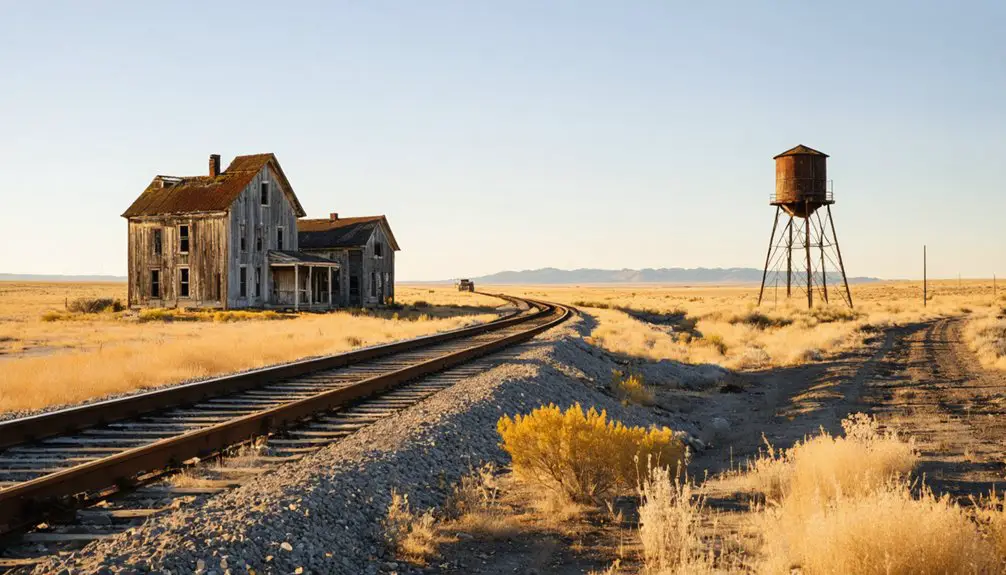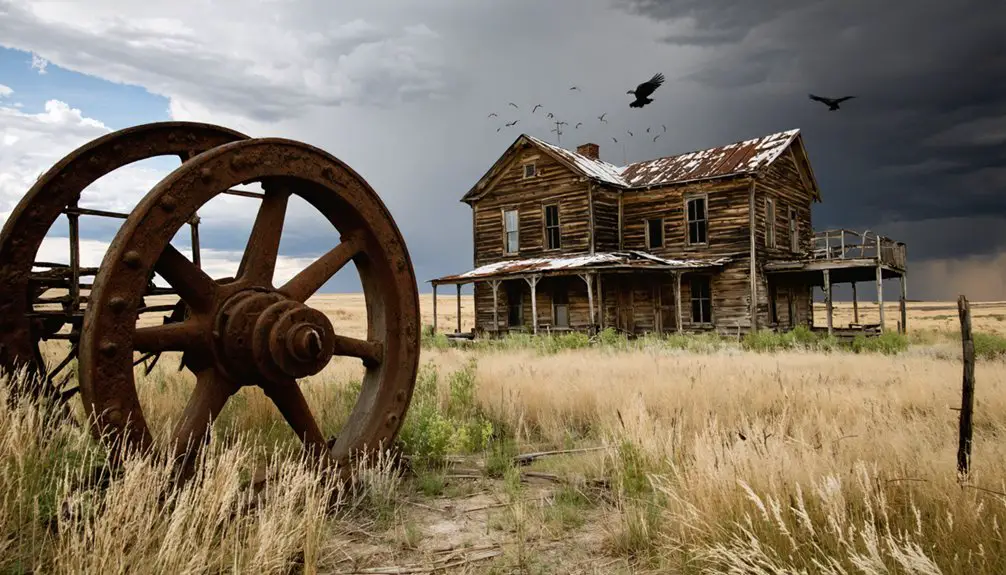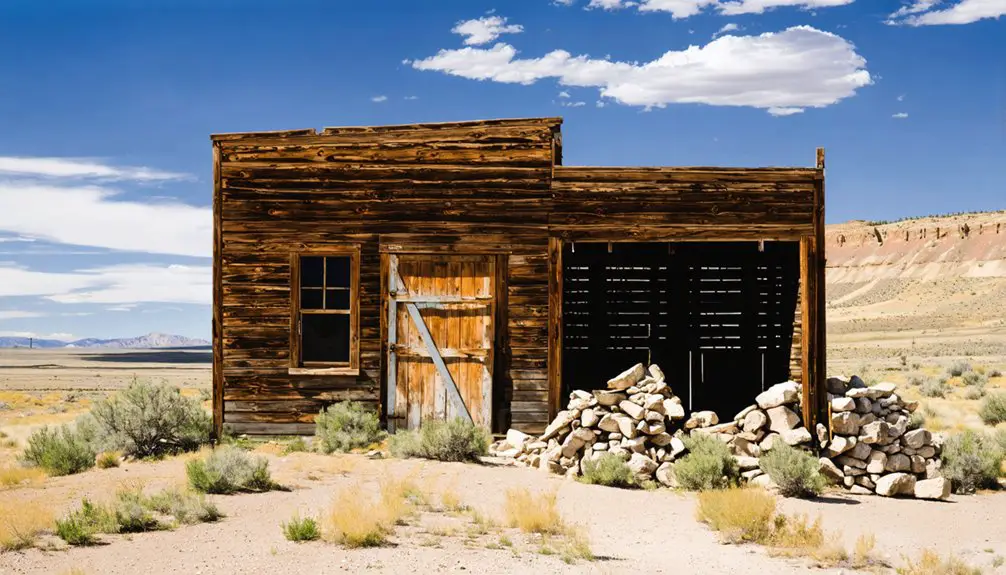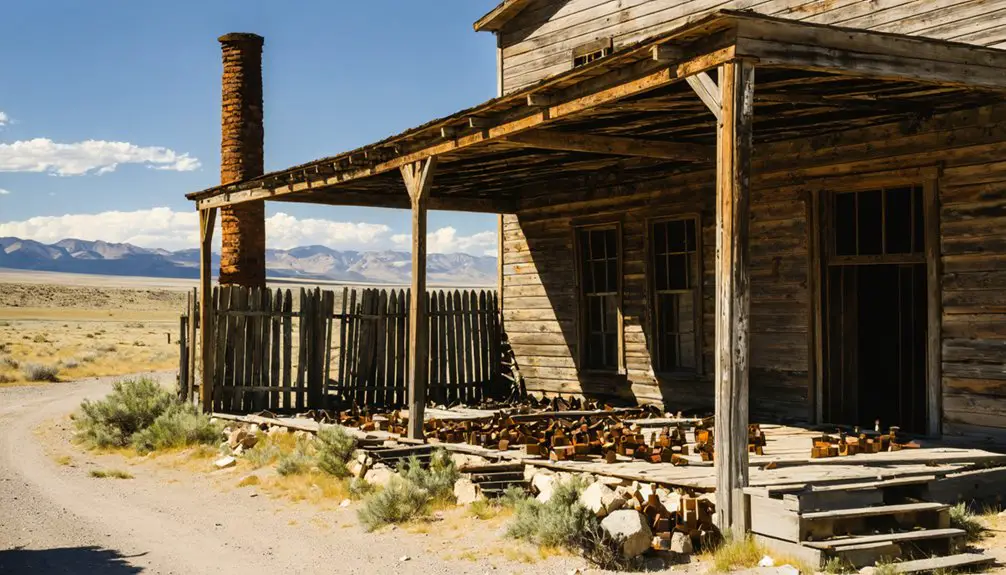You’ll discover Whoop-Up as one of Wyoming’s most notorious ghost towns, emerging in the late 1880s along the Chicago, Burlington, and Quincy Railroad line. This lawless frontier settlement featured saloons, brothels, and dance halls, where vigilante justice prevailed in the absence of formal law enforcement. The town’s brief but turbulent existence included high-stakes gambling, whiskey trade, and frequent violence. The abandoned site’s rich historical legacy holds fascinating tales of outlaws, traders, and frontier justice.
Key Takeaways
- Whoop-Up emerged in the 1880s as a railroad boomtown in Wyoming, competing with nearby settlements for a Chicago, Burlington, and Quincy Railroad depot.
- The town gained notoriety for its lawless atmosphere, featuring saloons, brothels, and dance halls with minimal law enforcement presence.
- Kid Curry’s gang and other outlaws found refuge in Whoop-Up, leading to the formation of vigilante groups for community protection.
- The whiskey trade generated substantial profits, with traders like Healy and Hamilton earning $50,000 in their first winter.
- Today, Whoop-Up exists only as a ghost town, with failed 1970s tourism revival attempts leaving just historical markers and archived stories.
The Rise of a Wild West Railroad Town

As the Chicago, Burlington, and Quincy Railroad pushed westward across Wyoming in the late 1880s, the settlement of Whoop-Up emerged as one of several ambitious towns vying for railroad supremacy.
You’ll find this town’s story intertwined with fierce railroad competition, as nearby Tubb Town and Newcastle joined the race to secure a coveted depot location.
The railroad’s presence sparked immediate growth, bringing saloons, general stores, and workers from the Burlington & Missouri River Railroad. The line’s expansion would eventually reach Billings, Montana by 1894.
Railroad tracks brought more than just trains – they carried civilization itself, with commerce and workers following close behind.
While Whoop-Up initially held promise, DeLoss Dewitt Tubbs’s establishment of Tubb Town in spring 1889 intensified the town rivalry.
The competition between these frontier settlements reflected the era’s spirit of opportunity and risk-taking, with residents readily relocating based on wherever the railroad seemed most likely to establish its hub.
Life in the Lawless Frontier
You’ll find Whoop-Up’s saloons, brothels, and dance halls represented the typical lawless frontier establishments where cowboys, miners, and drifters congregated for entertainment and trouble.
Without consistent law enforcement presence, these businesses operated with minimal oversight, contributing to the town’s notorious reputation for violence and vice. The absence of official policing led many communities to form vigilante groups that took justice into their own hands without proper trials.
The town’s isolation and position along rail lines made it particularly challenging for the few lawmen who attempted to maintain order, leading many residents to rely on informal justice and self-protection. Known outlaws like Kid Curry’s gang frequently used the area as a refuge from authorities, further cementing its dangerous reputation.
Wild West Saloon Culture
While the American frontier expanded westward, saloons emerged as essential establishments that shaped the social fabric of budding settlements.
You’d find these legendary establishments evolving from simple tents to elaborate wooden structures, each reflecting the raw spirit of frontier life through their saloon architecture and drinking rituals. Batwing doors became an iconic feature that defined these frontier establishments. The establishments often served as local economic hubs for growing towns and settlements.
In these rough-and-tumble establishments, you could witness:
- Cowboys, miners, and trappers sharing potent whiskey concoctions like “Red Dynamite” and “Taos Lightning”
- High-stakes poker games that could turn friends into enemies in an instant
- News and stories exchanged across polished wooden bars, where fortunes were made and lost
- A stark reflection of frontier freedom, where social classes mixed freely despite the ever-present threat of violence
These saloons weren’t just drinking establishments – they were the beating heart of the Wild West.
Brothels and Dance Halls
In the untamed expanse of Whoop-Up, brothels and dance halls formed an intricate network of vice that defined the town’s lawless character.
You’d find a clear brothel hierarchy, from high-end parlor houses to bare-bones cribs where leather rainslickers protected mattresses from muddy boots. In these basic rooms, workers served 20-30 clients nightly. Just as in Cheyenne’s House of Mirrors, these establishments maintained strict class distinctions in their operations. The recently restored Rose Williams Roadhouse exemplifies this frontier history with its simple three-room structure.
The entertainment venues created a bustling ecosystem of pleasure and profit. Dance halls doubled as recruitment grounds while providing miners and railroad workers with music, gambling, and loose supervision.
You’d witness initiation customs like buying rounds for the house, fostering a rowdy atmosphere. While law enforcement remained deliberately lax, brothels often paid monthly “fines” that functioned as unofficial licenses, keeping the wheels of commerce turning in this frontier economy.
Law Enforcement Challenges
During Whoop-Up’s early years, the absence of formal law enforcement created a powder keg of violence and illegal trade along the Medicine Line.
The law enforcement dynamics shifted dramatically when the North-West Mounted Police arrived in 1873, but controlling this vast frontier proved challenging. The NWMP established Fort Macleod headquarters to effectively patrol the region’s sprawling territory. The Cyprus Hills Massacre in 1873 was a turning point that led to the NWMP formation and stricter enforcement.
If you’d lived in Whoop-Up during this period, you’d have witnessed these critical challenges:
- Cross-border outlaws exploited jurisdictional challenges, easily slipping between U.S. and Canadian territories
- Remote geography made it nearly impossible to maintain consistent police presence
- Witness intimidation prevented successful prosecution of violent traders and criminals
- Tensions between indigenous peoples and settlers complicated peacekeeping efforts
John Healy served as the region’s de facto sheriff before official authorities arrived, but the territory’s lawless nature persisted until the NWMP established firm control by 1874.
Economic Boom and Entertainment
You’ll find that Whoop-Up’s economic prosperity centered on its bustling entertainment district, where saloons and dance halls catered to railroad workers seeking respite from their grueling jobs.
The strategic location as a railhead brought a steady stream of workers who spent their wages freely on whiskey and leisure activities, creating lucrative profits for establishment owners. Similar to when Thomas Durant’s workers demanded back wages in 1869, railroad employees often had disposable income to spend in town once paid.
These entertainment venues functioned as both social hubs and economic drivers, transforming Whoop-Up into a flourishing frontier town during the railroad boom of the late 1880s.
Saloons and Dance Halls
As Whoop-Up transformed into a bustling railhead town, saloons and dance halls quickly dominated the local economy, establishing the settlement’s reputation as a rough-and-tumble entertainment hub.
You’d find at least 14 saloons scattered throughout the town, their saloon architecture ranging from basic wooden structures near the jail to more elaborate establishments offering games and entertainment.
The town’s nightlife centered around four key features:
- Dance hall entertainment featuring nightly music and dancing
- Card tables and pool rooms fostering social interaction
- Five hotels supporting the constant flow of visitors
- Brothels operating alongside the main entertainment venues
These establishments catered primarily to single male workers, creating a rowdy atmosphere that often overwhelmed local law enforcement.
You’ll notice how these venues filled the void of structured activities, serving as the heart of community social life until the town’s eventual decline.
Railroad Worker Entertainment
While saloons dominated Whoop-Up’s entertainment scene, railroad workers found diverse leisure activities that shaped the town’s economic prosperity.
You’d find workers gathering at makeshift theaters for music and plays, or cheering at informal baseball games and boxing matches. Their well-earned wages fueled local businesses, from hotels to repair shops.
Railroad camaraderie flourished through communal activities like storytelling circles and group singing, while cultural exchanges between workers of different ethnic backgrounds enriched the social fabric.
Traveling circuses and temporary shows brought excitement to the town, drawing crowds during workers’ downtime.
Beyond gambling halls and card games, you’d discover a vibrant entertainment ecosystem that included everything from sporting events to religious services, all contributing to worker morale and the town’s economic significance.
Whiskey Trade Profits
The whiskey trade transformed Whoop-Up into a booming economic powerhouse starting in 1869, when traders John J. Healy and Alf Hamilton established their legendary trading post.
Their whiskey economics revolutionized regional commerce, netting an impressive $50,000 profit in just their first winter of operations.
You’ll find these trading practices dominated the local economy:
- Traders maximized profits by adulterating cheap whiskey with tobacco, red pepper, and other ingredients.
- Buffalo robes became the primary currency, creating wealthy merchants like C. Power and I.G. Baker.
- Over 50 trading posts emerged by 1874, forming a vast network of commerce.
- Smuggling tactics evolved to avoid detection, including hidden leather compartments.
The trade’s incredible profitability sparked a gold rush mentality, with entrepreneurs flocking to capitalize on the lucrative whiskey-for-robes exchange that defined Whoop-Up’s economic heyday.
Native American Heritage of Whoopup Canyon
Stretching across four miles of Dakota sandstone in northeast Wyoming, Whoopup Canyon holds an extraordinary collection of roughly 150 rock art panels that illuminate the rich Native American heritage of the region.
You’ll find sophisticated petroglyphs depicting deer, elk, mountain goats, antelope, and bison – but importantly, no horses. These artworks reveal ancient hunting methods through detailed scenes of snares and game nets.
The canyon’s Native heritage spans thousands of years, with evidence suggesting occupation since Paleo-Indian times.
You can explore habitation sites on the ridgetops, marked by stone circles and chipped artifacts.
Modern Shoshone and other tribes maintain cultural connections to these ancestral lands, collaborating with archaeologists to interpret and protect their sacred legacy while ensuring accurate representation of their spiritual and hunting traditions.
The Railroad’s Broken Promise

Despite grand promises of economic transformation across Wyoming Territory, railroad development in the 1800s largely bypassed small settlements like Whoop-Up, focusing instead on major east-west corridors that served Union Pacific’s transcontinental ambitions.
You’ll find that railroad expectations versus reality played out harshly for towns like Whoop-Up:
- While major hubs like Cheyenne thrived with rail connections, smaller settlements remained isolated from the economic benefits of rail transport.
- Local railroad companies repeatedly failed to establish viable routes to remote areas, leaving Whoop-Up dependent on outdated trade paths.
- The Wyoming North and South Railroad’s collapse exemplified broken promises of connectivity.
- Without direct rail service, Whoop-Up couldn’t sustain its commercial relevance once alternative transportation methods emerged and traditional trade declined.
Legacy of a Ghost Town
While Whoop-Up’s physical structures have long since vanished, its complex legacy endures through compelling stories of frontier life, economic lessons, and cultural impact on Wyoming’s identity.
You’ll find its spirit preserved in tales of saloon owners serving drinks from wagons during relocation and the infamous town-wide brawl that sent law enforcement fleeing.
The town’s rapid rise and fall serves as a stark reminder of how railroad decisions could make or break frontier settlements.
Though attempts to revive Whoop-Up as a tourist destination in the 1970s failed, cultural preservation efforts continue through historical markers and archived accounts.
The story of these transient communities – from Whoop-Up to Tubb Town – enriches Wyoming’s heritage, embodying the untamed spirit and economic volatility of America’s western expansion.
Archaeological Discoveries and Cultural Significance

Beyond the ghost town’s remains, the Whoop-Up area holds remarkable archaeological significance through its extensive collection of 150 rock art panels stretching across four miles of Dakota sandstone.
You’ll discover evidence of ancient cultural practices that shaped this region’s history.
The archaeological importance of the area reveals itself through:
- Petroglyphs depicting hunting techniques with snares and game nets
- Small habitation sites featuring stone circles and chipped artifacts
- Ritual offerings and spiritual symbols carved into rock faces
- Evidence of Paleoindian presence dating back 16,000 years at nearby Sunrise
These findings have revolutionized our understanding of early Native American life in Wyoming, challenging previous assumptions about settlement patterns and cultural practices.
Through the rock art, you’re witnessing a preserved record of prehistoric beliefs, hunting methods, and community activities.
Frequently Asked Questions
What Happened to the Original Buildings and Structures of Whoop-Up?
You won’t find any building preservation or historical artifacts today – the original structures were destroyed by a reservoir dam failure in 1900, while remaining buildings deteriorated naturally over time.
Were There Any Notable Gunfights or Famous Outlaws in Whoop-Up?
Like tumbleweeds in the wind, you won’t find documented gunfights or outlaw legends in Whoop-Up’s history books. Records show Wyoming’s famous shootouts and desperados were active elsewhere in the territory.
How Did Residents Get Their Water and Food Supplies?
You’d find your water sources in local creeks and springs, while digging wells for groundwater. For food, you’d hunt game, forage plants, and rely on supply wagons for basic food trade.
What Was the Exact Population of Whoop-Up at Its Peak?
You won’t find exact population trends or ghost town statistics for this settlement’s peak – historical records don’t preserve specific numbers, though comparative data suggests it likely hosted fewer than 1,000 residents.
Did Any Famous Historical Figures Ever Visit or Stay in Whoop-Up?
You won’t find any famous visitors in historical records, as research shows the town’s historical significance centered on local figures like Ralph Olinger and scholars studying nearby rock art sites.
References
- https://kids.kiddle.co/Tubb_Town
- https://fort.galtmuseum.com/history
- https://www.wyohistory.org/encyclopedia/rock-art-whoopup-canyon
- https://en.wikipedia.org/wiki/Tubb_Town
- https://sites.rootsweb.com/~wytttp/ghosttowns.htm
- https://mhs.mt.gov/Shpo/docs/MPDs/MT_MultipleCounties_WhoopUpTrailMPD.pdf
- http://www.wyomingtalesandtrails.com/gillette.html
- https://www.wyohistory.org/encyclopedia/wyoming-north-and-south-railroad-1923-1935
- https://www.onlyinyourstate.com/state-pride/wyoming/johnson-county-wyoming-history-wy
- https://www.historyextra.com/period/victorian/wild-west-how-lawless-was-american-frontier/



